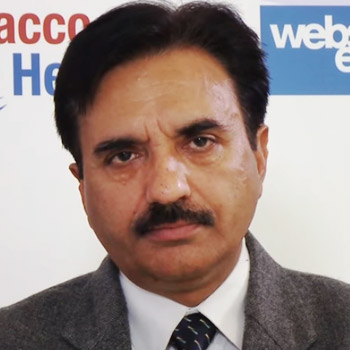
As a pulmonologist working in India, Dr Rana Singh came across people with lung diseases caused or exacerbated by tobacco use, day-in, day-out. Many of his patients had tuberculosis.
‘India has the highest burden of tuberculosis and the second highest burden of tobacco use. This is not unusual,’ says Singh. ‘In fact many countries with a high TB burden also have high rates of tobacco consumption. What is amazing to me is that we still do not treat them together.’
Despite overwhelming evidence on the efficacy of integrating cessation support with patients’ TB treatment regimens, no country yet has a national strategy for achieving this. India will introduce such programmes in six states in early 2016. Singh and his team are working with WHO under the leadership of the Ministry of Health to create training material for this pioneering launch.
‘My work in tobacco control began when I became a chest physician – I was always advising patients to quit tobacco. But it was one-off advice and its impact was not assessed. The beauty of integrating tobacco cessation into TB treatment is that experts have the opportunity to give sustained support and advice to patients. This is needed, it’s incontrovertible – in India 40% of middle-aged male patients who die from TB use tobacco.’
In 2007 Singh joined The Union to lead its tobacco control programme in India – establishing politico-administrative support, building infrastructure and capacity, forming coalitions, enforcing legislation, disseminating public information and monitoring and evaluating progress. Although India already had a national tobacco control law, it faced many challenges. Over the past eight years Singh and his team have supported this national tobacco control cell and helped establish equivalent cells within the country’s 29 state level governments and 350 districts.
‘The Union’s engagement with governments is unique. We do not engage in activism. Rather we respect viewpoints, we listen to understand challenges and we work together to overcome these things. We are a dependable partner. Although this approach takes time, the programmes we build are sustainable because they become institutionalised, something permanent.’
The introduction of 100 per cent smokefree areas across 108 districts and cities is one of The Union’s greatest achievements in India to date, protecting more than 230 million people. The team’s capacity-building work is also impressive – more than 250,000 stakeholders have received tobacco control training and more than 700 have received technical training on the WHO FCTC’s key measures, including Article 5.3.
‘The biggest challenge we now have is tobacco industry interference and conflict of interest within governments. We saw the consequence of this last year, when the then Minister of Health Dr Harsh Vardhan introduced a number of very wise and strong tobacco control policies in quick succession. Soon afterwards he was asked to stand down.’
The government received thousands of letters of protest in response to just one of Dr Vardhan’s policies – to introduce the world’s strongest graphic health warnings on all tobacco products, covering 85 per cent of surface area, front and back.
‘Many of these responses were coordinated by industry front groups – including tobacco farmers and those involved with producing bidis. Now the High Court of Rajasthan has ruled that the 85 per cent warning must be introduced, and this will happen in April next year. But until we resolve these conflicts of interest, life-saving laws will be obstructed and delayed, and ultimately more lives lost.’
Singh and his team are working from the ground up to combat tobacco industry interference.
‘We are beginning at the sub-national level, working with state governments. Punjab state is now fully aligned with Article 5.3 of the World Health Organization’s Framework Convention on Tobacco Control [WHO FCTC] and its measures to mitigate industry interference. This autumn, seven more states committed to doing this too. This is huge progress.’
As the WHO FCTC’s seventh Conference of Parties is slated to meet in India next year, Singh aims to use the international focus to push several key policies – raising the legal age for tobacco sales to 21, removing all exemptions to smokefree laws and rationalising taxes across all tobacco products including bidis, which remain comparatively low in price.
‘Many milestones have been achieved here – all through the dedication, hard work and commitment of people at many political levels in India, government authorities, health ministers, city mayors. None of this could have been achieved without them. Next year India will have its second Global Adult Tobacco Survey. We hope this will show a drop in tobacco consumption, creating yet more impetus for our politicians to support this vital work.’
